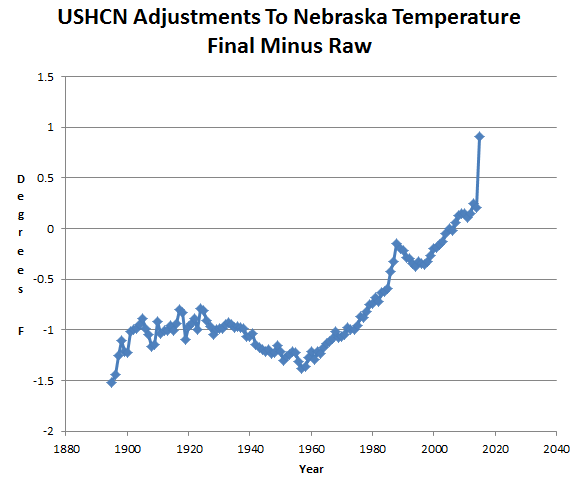We’ve got Armadillos in our trousers. It’s really quite frightening.
– Nigel Tufnel Spinal Tap
In 1974, climatologists reported a steady global cooling trend since WWII and retreat of Armadillos from Nebraska.
NASA now shows no post WWII global cooling, and 1973 as the hottest year since 1880
Armadillos didn’t return to Nebraska until about a decade ago.
By 1995, the species had become well established in Texas, Oklahoma, Louisiana, Arkansas, Mississippi, Alabama, and Florida, and had been sighted as far afield as Kansas, Missouri, Tennessee, Georgia and South Carolina. A decade later, the armadillo had become established in all of those areas and continued its migration, being sighted as far north as southern Nebraska, southern Illinois, and southern Indiana.
So how did government scientists make armadillos disappear from WWII Nebraska? They simply cooled Nebraska’s past by 1,5 degrees and warmed the present by 1.0 degrees.





We have to stop all this Gorebal Warming!!!!
http://www.cbc.ca/news/canada/nova-scotia/nova-scotia-aquaculture-fish-killed-by-superchilled-water-1.2980172
Interesting Spinal Tap reference.
Ive often referenced my favorite scene in the film in the CAGW debate.
“Why not just make 10 louder?”
“These go to 11”
When I was stationed in Ft. Sam Houston, San Antonio, TX I noticed that instead of the Possum road kill I was used to seeing the predominate road kill down there was Armadillos. Possum on the half shell.
Oh by the way, Opossum is the greatest single animal carrier of the Gram positive rod bacillus that causes Hanson’s disease (Leprosy) in the US. Transmission to humans from wild opossums either dead or alive has been confirmed. So don’t fool with them without taking precautions. Though about 95% of the population of the US is not susceptible to the infection and Hanson’s disease is treatable but you wouldn’t want to go through it unless you like the idea of having purple skin for a few months. The treatment involves a lot more than “take these pills and call me in the morning”.
Darn it! The carrier is the Armadillo NOT the Opossum. Sorry. Banging my head on the desk!
Day after day, example after example – Is there anyone putting it all together and writing a book?
Yes I am.
(-:
Be careful Tony. The US Government has a history of censorship.
Congressman Charles Lindbergh was a strong opponent of the Federal Reserve Act. He wrote books such as “Why your country is at war” just before Pearl Harbor and another earlier book “Banking and Currency and the Money Trust” about the banks and how by expanding credit then withholding it wreck the economy. Government Agents visited his printer on order of the US Government smashed the plates and confiscated most of the printed books. A few copies still remain.
Speaking of new books, while getting the names of Charles Lindbergh Sr.’s books I ran across this brand new book:
The Impacts of Genetic Engineering: Not Science, Just Lies and Propaganda: The Massive Fraud Behind GMOs Exposed
‘Altered Genes, Twisted Truth’, a new Book by US Public Interest Lawyer Steve Druker.
……………
Too bad WordUnimpressed ate my earlier comment on the Dog and Pony show aka congressional hearings. It was about the Hallmark Downer Cow hearings and the corruption of the USDA that was swept under the rug despite the hearing. I have no problem with the idea of GMOs but given the fact that Monsanto’s Lawyer, Michael R. Taylor was a top dog at the FDA under Clinton and declared GMOs ‘equivalent’ to natural a have a wee bit of a question mark. Taylor is also back in the FDA thanks to Obummer.
I am reproducing the lost comment since it has baring on the Congressional hearing Dog and Pony Shows and even the Bush Energy policy. (Remember Enron and BP met in Bush’s office to discuss getting rid of coal)
The corruption in DC is really sickening.
…………
In other words folks, what Edgar Salsbury, a former state food inspector, said rings more true today than ever before. At our first meeting I asked him, “Which part of the law applied to food processing?” He replied, “The part that screws the little guy and lets the big guys get away with murder.” (wwwDOT)newsofthenorth.net/article.cfm?articleID=24209
Government Accountability Project: Shielding the Giant – USDA’s “Don’t Look, Don’t Know” Policy
The USDA ‘looked into’ this testimony and called Stan Painter a LIAR about a year later. This was followed by a major push to ‘update’ the antiquated food safety system. Never mind HACCP had already been introduced in 1996 and the CDC data showed the food borne disease rate DOUBLED. (I plotted three years before and three years after from the CDC data.)
“Evidence of Weak Meat Inspection Program Found in Nearly a Thousand Violations of Mad Cow Rules at Slaughter Plants,” Public Citizen, August 18, 2005,
http://www.citizen.org/pressroom/release.cfm?ID=2024
On another matter:
A newer URL: usatoday30(DOT)usatoday.com/news/washington/2008-02-28-4261447442_x.htm
It was an inside job. Those were government armadillos, and the Nixon administration wanted a reason to go to war with Vietnam, so they programmed armadillos to only migrate south. This caused the world to wobble from the armadillo imbalance, making Vietnam unstable and all communisty. Another false flag operation.
My favourite false-flag operations are the ones that propagate backwards in time.
Then again, consider when we actually started sending “military advisors” there, & who was vice-president then (Barkley!). Obviously the armadillo plot was being fought by Truman & Nixon, & all this went to hell when Truman died & Nixon was able to send his mighty armadillo troops South again. South, South Vietnam! IT ALL FITS!!
*foams*